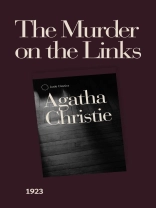Christie’s third novel, ‘The Murder on the Links, ‘ published in 1923, is a pivotal work in the development of her iconic detective, Hercule Poirot. This intricate mystery, set in northern France, showcases Christie’s evolving mastery of the whodunit format and her skill in crafting complex, misleading plots. The novel is particularly noteworthy for its use of multiple narrators and its exploration of the unreliable narrator trope, techniques that were innovative for the genre at the time.
The story, which centers on the murder of a wealthy businessman on a golf course, delves into themes of jealousy, blackmail, and the long-reaching consequences of past actions. Christie’s portrayal of Poirot in this novel helps to solidify many of the character traits that would become his hallmarks, including his methodical approach to investigation and his emphasis on psychology over physical clues.
Historically, ‘The Murder on the Links’ reflects the post-World War I fascination with continental Europe and the changing social dynamics of the early 1920s. The novel’s exploration of class distinctions and the impact of the war on social structures provides valuable insights into the period’s societal concerns.












